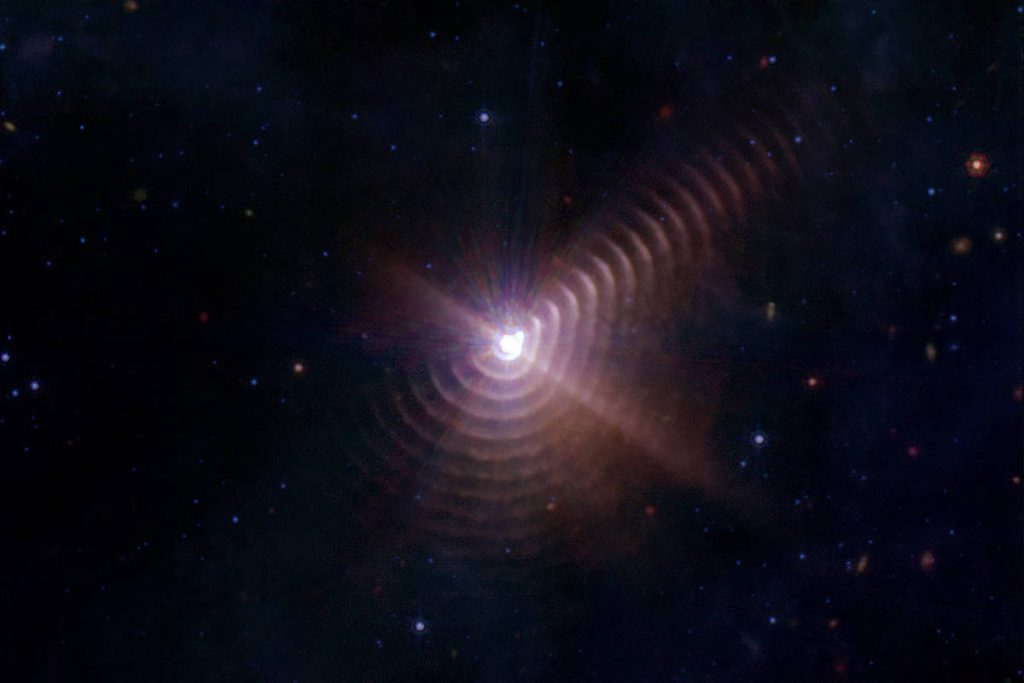a James Telescope webGive NASA, snapped an image of 17 dust rings produced by a pair of stars, located 5,000 light-years from Earth. According to NASA, Which released the information on Wednesday (12)the image corresponds to the duo’s “fingerprint”, which is called Wolf-Rayet 140 (WR 140).
According to astronomer Ryan Lau, of NOIRLab, the capture corresponds to more than a century of space dust production. Says the expert, who is the lead author of a new study on this system. , published in the scientific journal natural astronomy.
According to the statement published by NASA, the Wolf-Rayet 140 duo consists of type O stars, the oldest of which is called Wolf-Rayet. This type of star is born with a mass of at least 25 times the mass of the Sun in our system.
Both stars eject streams of gases into the outer space The so-called stellar wind, and the amount of gas produced increases with age, since it burns more than in its youth. The Wolf-Rayet in this duo may have lost more than half of its original mass through the process.
Because they have entangled orbits, the two stars from time to time end up getting close to each other – roughly the same distance as the Earth and the Sun. At this time dust rings are formed, due to the collision between the stellar winds that expel them.
When they meet, the gas is compressed and turns into dust. In this system, this happens every eight years.
“Some other Wolf-Rayet systems form dust, but they are not known to make rings like Wolf-Rayet 140. The single-ring pattern forms because the orbit of the Wolf-Rayet star at WR 140 is elongated rather than circular.” from the US Agency.
These dust circles indicate the passage of time, like rings growing inside tree trunks. the trees. That’s why the discovery was called a fingerprint.
Research can help understand the formation of stars and galaxies
The study authors believe that the stellar winds from WR 140 also swept away other remaining material from the region in which it is located. This is why the rings remain unchanged rather than smeared or scattered.
“There will likely be more episodes that have become so faint and scattered that even Webb can’t see them in the data,” the statement read.
According to NASA, this type of system may have played an important role in the formation of stars and planets.
“When the Wolf-Rayet clears a region, material that has been swept up in the surrounding regions can accumulate and become dense enough to form new stars. There is some evidence that the Sun formed in such a scenario,” according to the agency.
thanks for the Webb technology, called mid-infrared instrument (MIRI), which detects longer infrared wavelengths, the researchers obtained better evidence that Wolf-Rayet stars produce carbon-rich dust particles. That’s because MIRI is able to visualize cooler objects, such as dust rings, and reveal their composition.
“Although Wolf-Rayet stars are rare in our galaxy because they are short-lived, […]It is possible that they produced a lot of dust over the course of the galaxy’s history before it exploded and/or formed black holes‘,” says Patrick Morris, an astrophysicist at Caltech (Caltech), in United Stateand co-author of the new study, in the statement.
“I think that with NASA’s new space telescope, we will learn a lot about how these stars form material among themselves and stimulate the formation of a new telescope in the stars. galaxies. “

“Incurable thinker. Food aficionado. Subtly charming alcohol scholar. Pop culture advocate.”






More Stories
NASA Releases Selfie of Perseverance Rover Working on Mars
NVIDIA driver includes hidden Final Fantasy XVI profile
PlayStation Plus Extra and Premium saw a significant drop in players in July